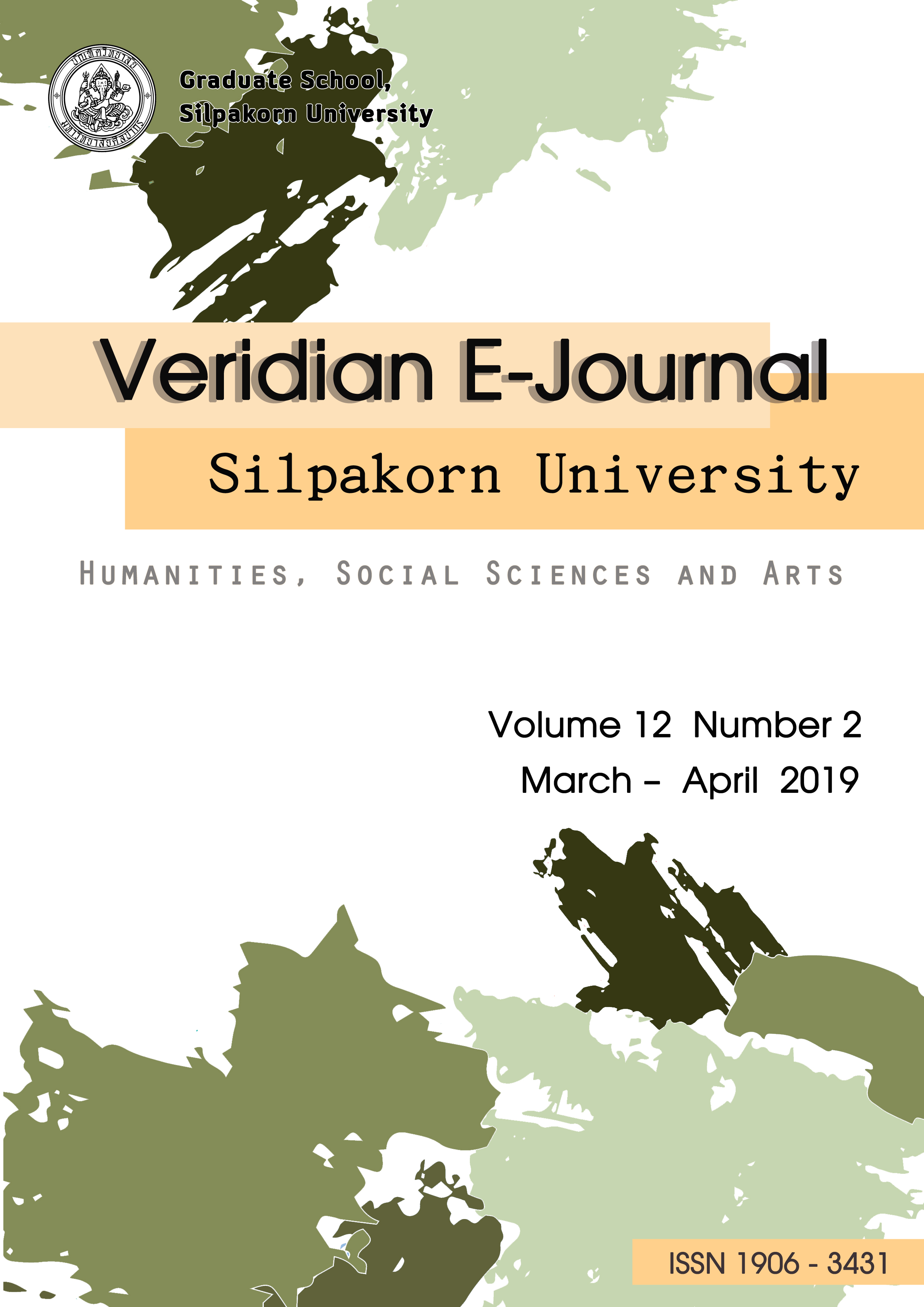Kon Dee Sri Pak Pra” Community Communication Network To Enhance Water Conservation Consciousness
Main Article Content
Abstract
The purposes of this study were (1)to develop the “Kon Dee Sri Pak Pra”community communication network to enhance water conservation consciousness and (2)to examine the effectiveness of the “Kon Dee Sri Pak Pra” community communication network to enhance water conservation consciousness. The sample consisted of 30 peoples in Pak Pra community; 25 persons, 3 leaders, 2 accommodation owners, derived through volunteer sampling method. The following research instruments were employed to collect the data : (1) the process of “Kon-Dee-Sri-Pak-Pra”community communication network to enhance water conservation consciousness, (2) the assessment form to affirm the process Sri-Pak-Pra in community network to enhance water conservation consciousness, and (3) the assessment of water conservation consciousness. Data were analyzed using percentage, mean and standard deviation.
The results of this study demonstrated that :
The manual of a Kon Dee Sri Pak Pra”community communication network to enhance water conservation consciousness were structured with conceptual framework, conceptual development, goals, activity plan, implementation guidelines, evaluation, and assessment duidelines. The details of the network components were as follows: (1) mutual purpose, (2) people (participants), (3) network linkage and collaboration, (4) creating a sense of togetherness, (5) development of transparency of network (6) information management. There were 5 steps of network process as follows; step 1 recognizing the need to build the network; step 2 establishing contact with prospective member organizations and association; step 3 establishing mutual obligation; step 4 developing alliance; step 5 implementing the activities together.
Network connection was functioned with several methods and communication strategies in order to create, maintain and expand networks.The most common form of communication in the community were "personal media" and "activity media." Activity media to mobilize the communication network were conducted through 7 networking activities: (1) self reliance and common foundation knowledge activities (2) organic farming activities (3) check-and-balance (mutual monitoring) activities (4) watershed cooperation activities (5) waste management activities (6) field trip activities, and (7) communication activities to promote water conservation. Means of communication included Line application, discussions at the village public meetings and face to face conversation. It was also recommended that the community members’ concrete benefits especially economical benefit to the should be emphasized in order to encourage them to cooperate and gear the campaign forward to he target. Regarding the comments from experts and the assessment of the Kon Dee Sri Pak Pra”community communication network to enhance water conservation consciousness, the operation of this community communication network to enhance the consciousness of water was found to be highly effective. Further after the implementation of community communiation network activities, the oerall score signifying level of water conservation consciousness of people in PaK Pra community appeared to be high in all aspects, average mean score of 4.37 and 0.35 SD.
Article Details
References
Buaniao, C. & Petchchaban, P. & Wiroteanant, M. & Bunraksa, Y. (2003). The development of communication network to protect U-Tapao canal. Retrieved from https://elibrary.trf.or.th/project_content.asp?PJID=RDG4540033
Buranee Wiangsimma. (2014). The Use of Communication to Create People Participation in Water Conservation at Khlong Saen Saep : Masjid Kamal-Ul-Islam Community, Bangkok. Retrieved from https://www.tci-thaijo.org/index.php/romphruekj/article/view/62769
Gongkum, R. (1998). The Development of Environmental Consciousness of Prathomsuksa 5 Students Using the Habitation Process (Master’s Thesis). Chiang Mai University.
Kaewthep,K. (2009). Analysis of media, concepts and techniques. Bangkok Faculty of Communication Arts, Chulalongkorn University
Kasinant, C. (2017). Creative Media to Enhance Water Conservation Consciousness of Basin CommunityYouths, Case Study : Khlong Tha Nae, Phatthalung. Songkhla : Thaksin University.
Krathwohl, D.R., Bloom, B.S., and Masia, B.B. (1964) Taxonomy of educational objectives: Handbook II: Affective domain. New York: David McKay Co.
Rogers, Everett M. (1962) . Diffusion of innovations. New York: Free Press of Glencoe.
Panangtung Subdistrict-Municipality. (April-4, 2017) Panangtung Subdistrict-Municipality development strategy number 4. Retrieved from https://www.phanangtung.go.th/panit.
Sthapitanonda, P. & Thiraphan, C. (2003). Communicate with social networks, create powerful networks. Bangkok : Local Development Institute.
Singnoi, B. (2013). The Role of Communication in Network Building and Public Consciousness Raising for Male Youth Volunteers. Retrieved from
https://www.dpu.ac.th/commarts/journal/upload/issue/PORMnG3YNc.pdf
Topithak, K. & Srisakda, V. & Yingwanna ,S & Benjasri,W. & Kasinant, C. & Sinprajakpon, S. & Niramol, K. (2017). The Development of a Learning Process to Enhance Water Conservation Consciousness of Basin Community Youths’ Khlong Ta Nae, Phatthalung Province. Songkhla : Thaksin University.
Yingwanna, S. (2016). Evaluation of Water Conservation Consciousness based on 360
degree feedback . Songkhla : Thaksin University.

